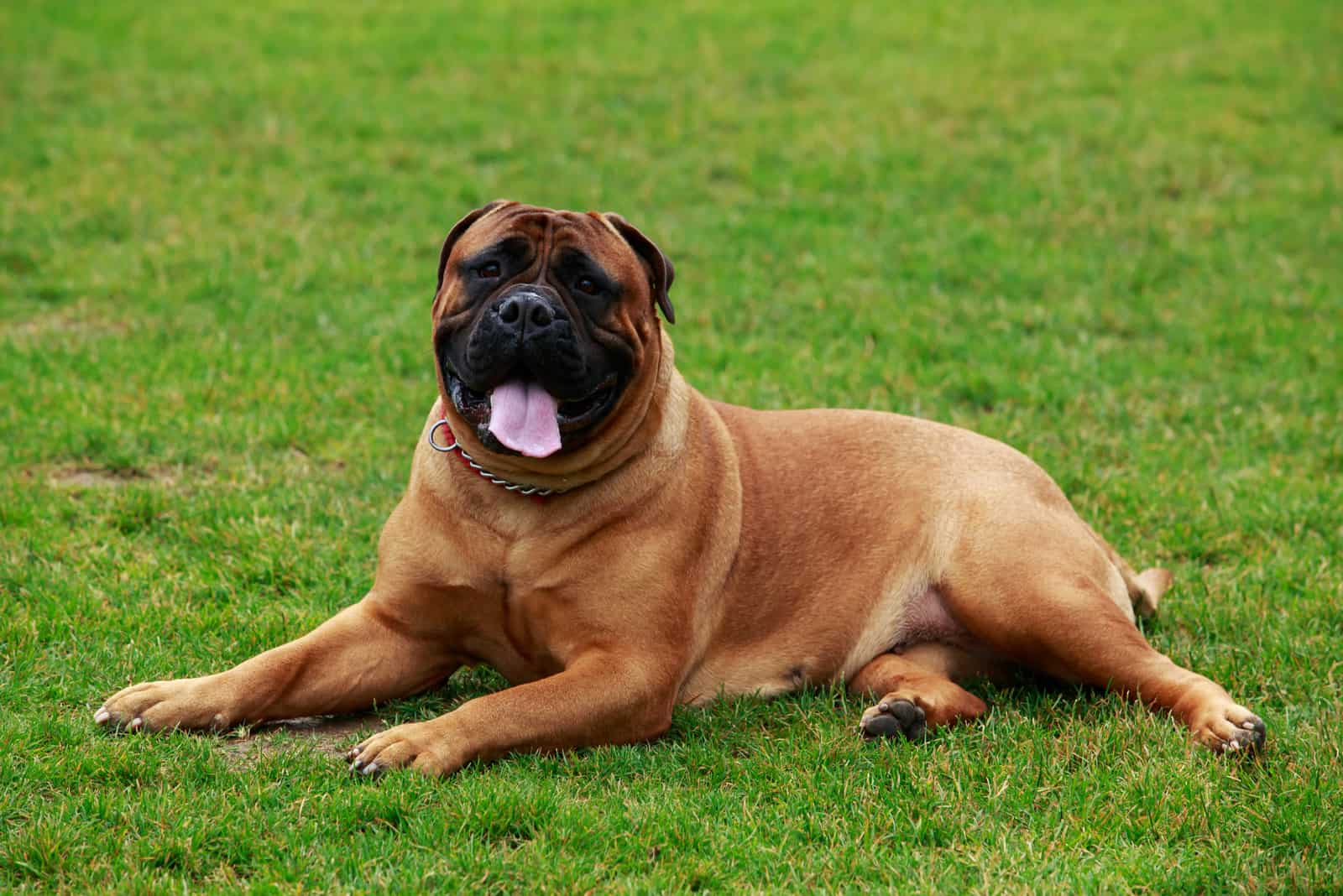Imagine you’re a gamekeeper in 19th century England. Yes, it’s an odd request, but bear with us! … You have a large country estate to protect from poachers who know that they’ll probably face the gallows if they get caught, but they risk it anyway, desperate to get food or to make cash by selling their ill-gotten gains.
If you confront the poacher, there’s a chance that they’ll attack you as they have nothing to lose. So, what do you do?
How about breeding an enormous dog that looks as intimidating as it sounds? It’s agile enough to chase down a fleeing trespasser, strong enough to pin them to the ground while you catch up, and its bark as well as its sheer size are usually enough to deter any would-be poachers. This dog has to be docile and trainable, but fearless and confident.
This is precisely how the Bullmastiff breed came to be! They quickly earned the reputation of being the gamekeeper’s night dog.
It’s an impressive pooch, bred by crossing the huge English Mastiff with the now-extinct Old English Bulldog. This gave it a short muzzle and a solid, more athletic build than the English Mastiff.
Obviously, poaching isn’t much of a problem these days, and there are few country estates left. Even if this were not the case, we would find another way of dealing with the problem by using modern technology.
This means that the vast majority of Bullmastiffs are kept as family companions and sometimes as guard dogs – often as both.
In this article, we’re going to examine the Bullmastiff colors as well as provide some answers to questions that people are always asking about these giants of the canine world.
Bullmastiff Coat Colors
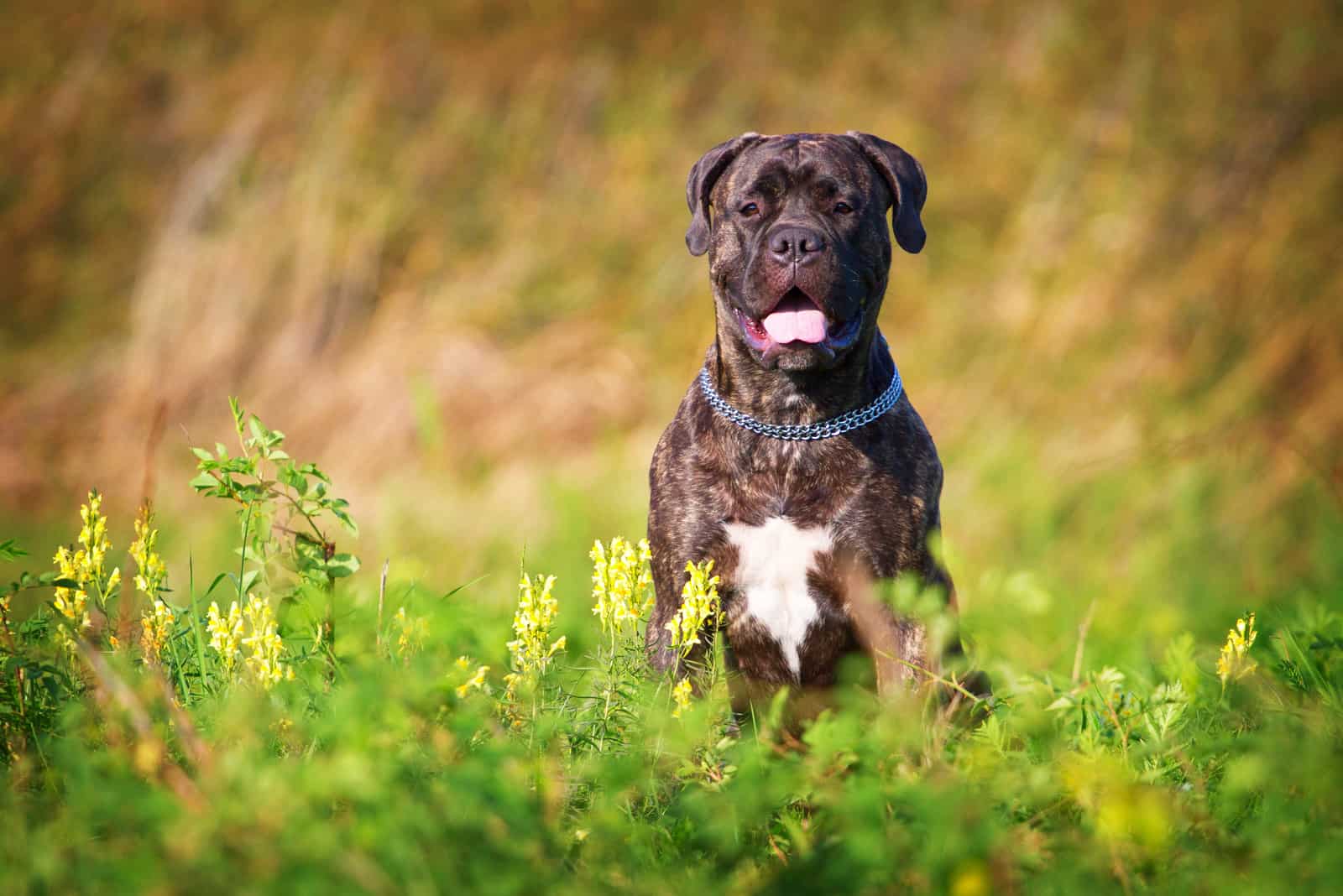
Have you ever wondered why dogs are the colors they are? Or, who decides this? Although nature obviously plays a part in this, humans have interfered with the process over the centuries by breeding dogs to look a particular way.
Certain organizations, such as the American Kennel Club (AKC) and the American Bullmastiff Association, set breed standards that dog breeders are expected to follow. These standards describe the average size, weight, shape, temperament, coat color, and general appearance of all dog breeds.
Why do they do this? Mostly to preserve the breed in its present form. Breed enthusiasts feel strongly about this, which is why they become anxious about mixed breed dogs, or designer dogs.
Also, there’s the question of health conditions that can be passed on to pups through irresponsible breeding practices. However, there’s a valid argument the other way: many breeds suffer specifically because breed standards insist that the dog should have a particular physical trait.
Anyway, back to Bullmastiff colors!
The AKC lists these as standard colors for the Bullmastiff:
• Fawn
• Red
• Red Fawn
• Fawn Brindle
• Red Brindle
• Red Fawn Brindle
And, they are allowed to have this marking:
• Black mask
Three further markings are listed as non-standard:
• Fawn mask
• Black mask with white markings
• Black markings
Your Bullmastiff is allowed to have these markings, but it’s not considered ideal. If you put your dog in a show, it would lose points because of these. In fact, if a Bullmastiff has a white spot on its chest that is thought to be too large, this would be a serious fault, and your dog may well be disqualified!
As you can see, there are only three main colors: fawn, red, and brindle. That’s a very limited list compared to most other breeds!
As there aren’t many to explore, we’ll look at each one in turn to see if we can find out more about them.
Bullmastiff Colors: Brindle
This was the preferred color of gamekeepers as it made excellent camouflage when the dog was roaming the estate at night.
However, brindle isn’t really a color; it’s a pattern in the dog’s coat. Actually, it’s also found in many other animals such as Guinea Pigs, cats, cattle, and sometimes in horses.
The brindle pattern is sometimes likened to tiger stripes, although it’s much more subtle and blended. It is usually formed with shades of red at the base, with black stripes over the top. The shades of color can vary widely, creating a whole range of brindle tones. In Bullmastiffs, some dark brindle dogs look almost completely black!
The spacing and thickness of the stripes vary, providing a whole range of different effects. If you thought Bullmastiff colors were limited, think again!
Bullmastiff Colors: Red
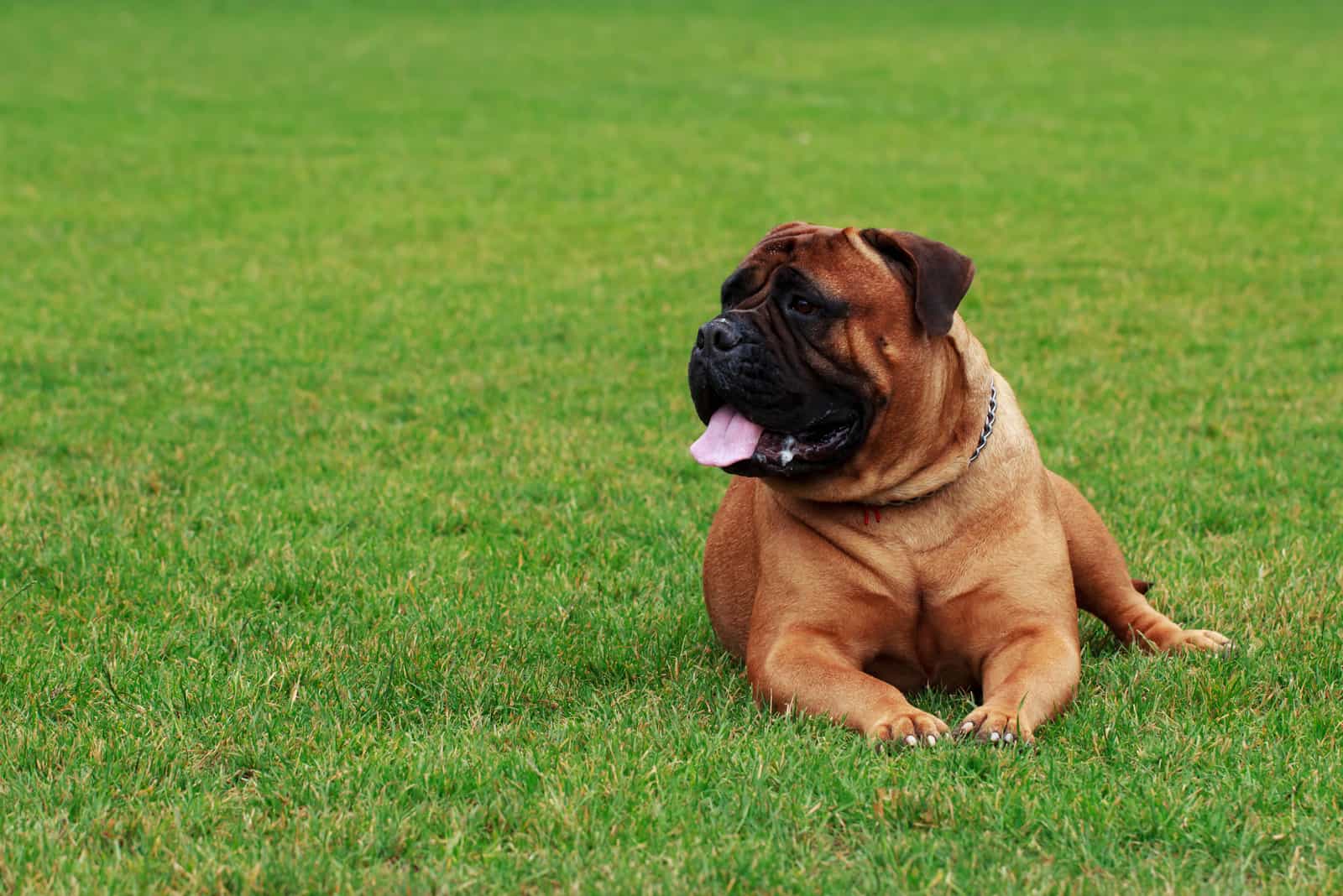
The shades of red run from a color that could almost be described as deep brown, right through to a lighter shade that’s difficult to distinguish from fawn. Some kennel clubs in countries around the world even include brown as a separate color in the breed standards just to make it easier for people to identify the color.
These dogs sometimes have a white flash on their chest, usually quite low, between the two front legs. According to AKC breed standards, this shouldn’t be too big or it will be classed as a fault.
Bullmastiff Colors: Fawn
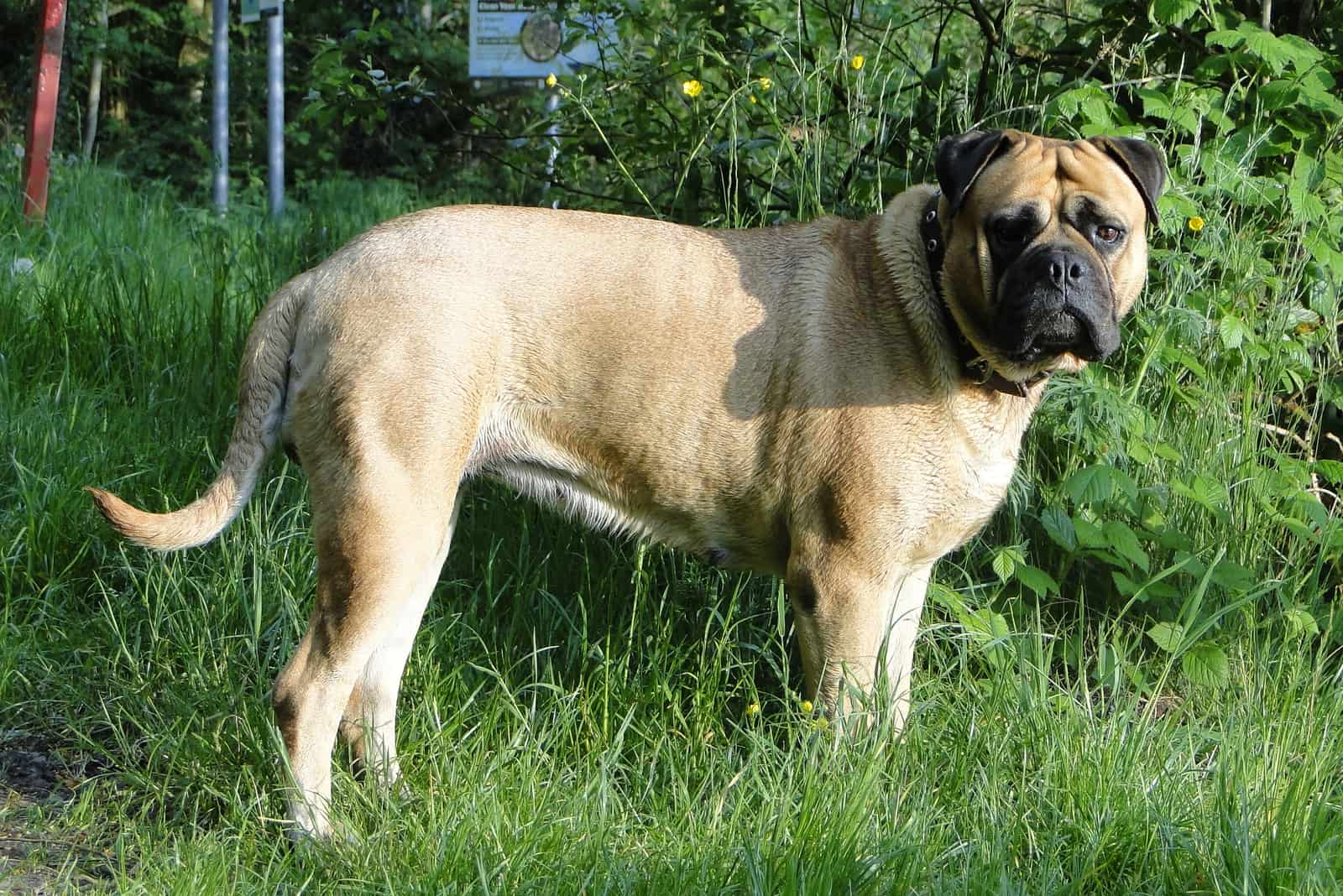
Fawn Bullmastiffs have overtaken reds and brindles to become the favorite color in recent times.
As with the other Bullmastiff colors, this can vary in tone, with countershading on the chest, legs, and underside of the dog. This gives the appearance of an almost two-color dog, but look closely and you’ll see that it’s all fawn!
Bullmastiff Eye Color
The AKC breed standards list the Bullmastiff eyes as dark, and of medium size.
This brief description isn’t overly helpful, but it means that the dog’s eyes are allowed to be hazel or brown; the darker the better.
It is possible for Bullmastiffs to have light-colored or even yellow eyes, but these are classed as serious faults.
See Rare Bullmastiff Colors below for more details!
Bullmastiff Puppy Colors
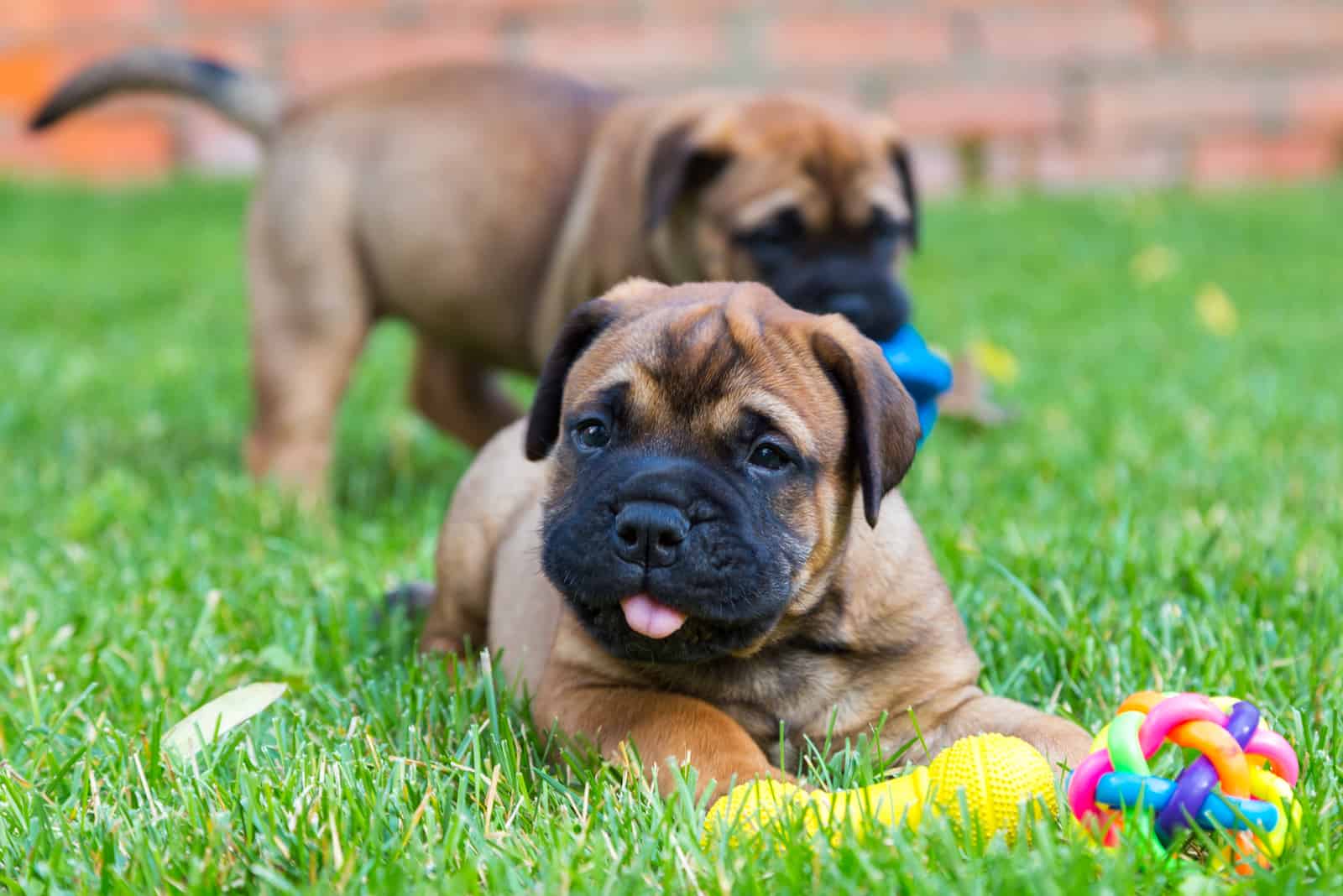
Like most breeds, there’s a good chance that your pup will have a different color coat when he grows up. It’s often difficult to tell exactly what color puppies are as the colors tend to be concentrated in their little bodies. So, a deep reddish-brown puppy may fade to a much lighter color. Markings might become more distinctive, or they may fade entirely.
This is why it’s not the best idea to choose your pup based solely on its color!
When you choose a puppy, it should be based on its overall health and temperament.
Rare Bullmastiff Colors
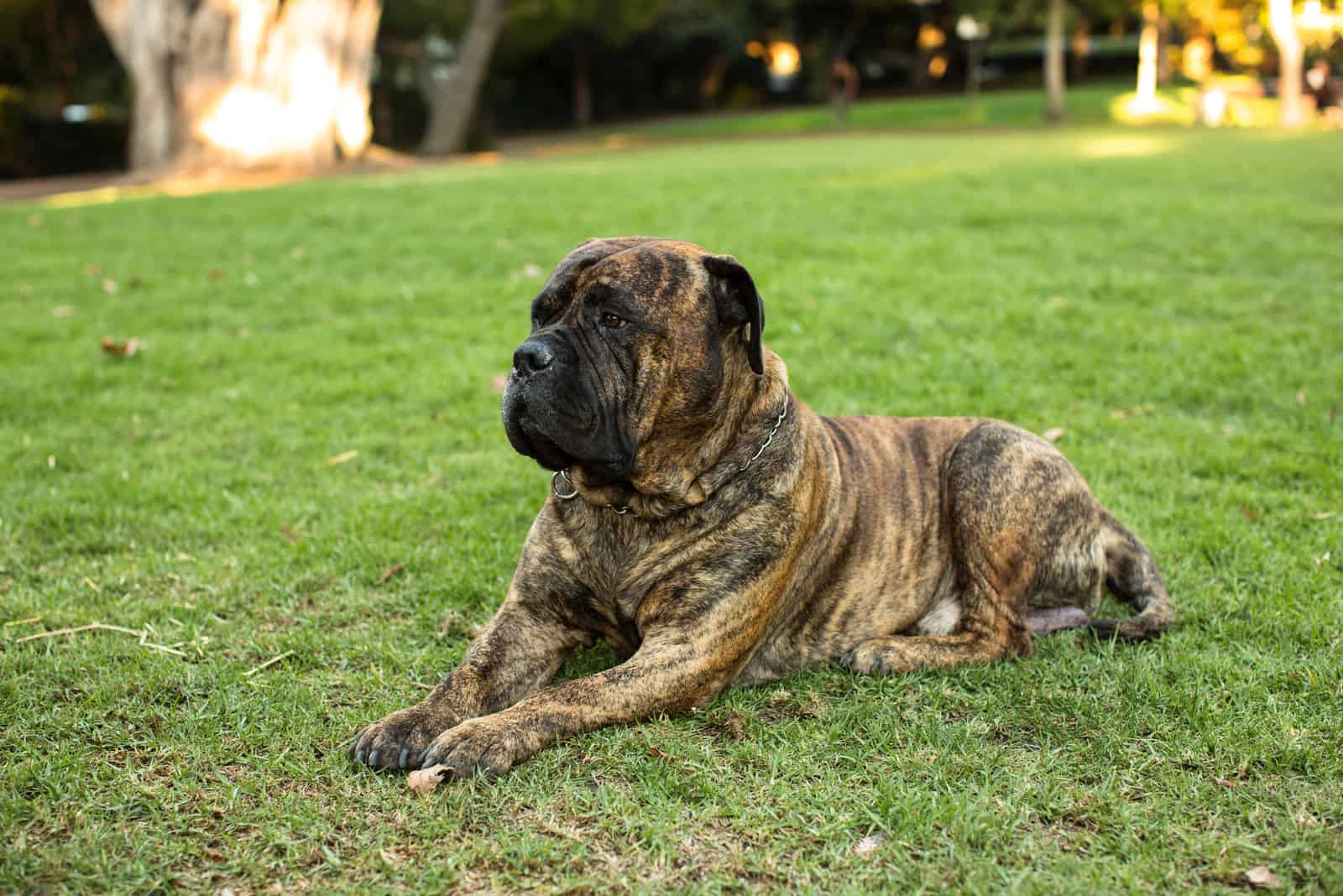
Brindle Bullmastiffs are fairly rare, especially ultra-brindle ones! Fawn Bullmastiffs are the most common, with the standard black mask.
Some brindle Mastiffs are so dark that they look completely black from a distance. Young Bullmastiff puppies can also appear to be very dark, leading people to believe that there is such a thing as a black Bullmastiff.
However, the purebred black Bullmastiff does not exist! You might see websites claiming otherwise, but this is either due to a lack of knowledge or they are deliberately misleading people. A true black Bullmastiff is only possible if it has been mixed with another breed; most likely a black labrador or a Cane Corso.
Also, there’s a good deal of confusion around the names of the Bullmastiff and English Mastiff, with some people confusing the two. So, you’ll find websites talking about English Bullmastiffs when there’s no such breed!
Otherwise, all Bullmastiffs fall within the fawn/red/brindle range of colors.
We should mention the rare Dudley Bullmastiff here as it is a genetic mutation that has caused controversy over the years. Dudley was a term used for Bulldogs with a pinkish nose. In Bullmastiffs, this genetic trait creates two different colorations:
• A gray/beige coat, a dark gray mask, and a gray nose, with yellow eyes.
• A fawn/red coat with a red mask, a pink/liver nose, and yellow eyes.
Some breeders will destroy pups with Dudleyism at birth, which is neither ethical nor acceptable behavior in this day and age. Others will sell the pups, with strict instructions to never breed or show them.
One could argue that they should focus on eradicating the serious, persistent health conditions in these breeds rather than overreacting about a rare genetic mutation.
How Are Bullmastiff Colors Made?
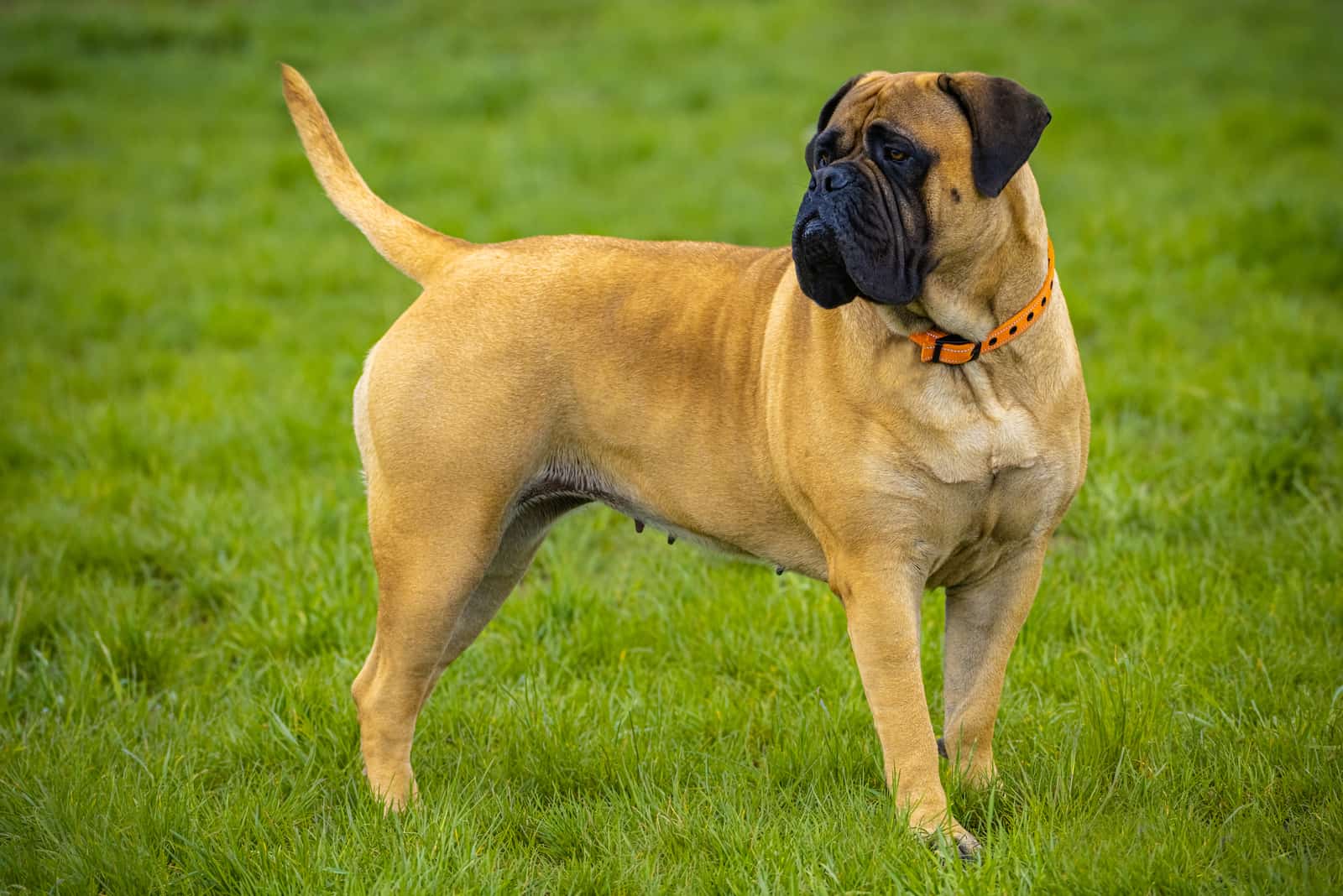
All dog coat colors are produced in the cells by two pigments called eumelanin and pheomelanin. Eumelanin provides black coloration, and pheomelanin makes red.
These pigments are affected by several different genes, which control how much of each one is present in the coat. And, this is how we get such a wide range of fascinating coat colors!
Eumelanin, the black pigment, is also responsible for the color of the nose and eyes, which shows that Bullmastiffs must have this pigment. However, this does not usually show in the coat, except in their distinctive black mask. This black fur is almost always restricted to the muzzle.
Pheomelanin is a red pigment, so how do we have fawn Bullmastiffs?
Well, the genes affecting coat color dilute the red so much that it fades to a fawn color!
What Type Of Coat Do Bullmastiffs Have?
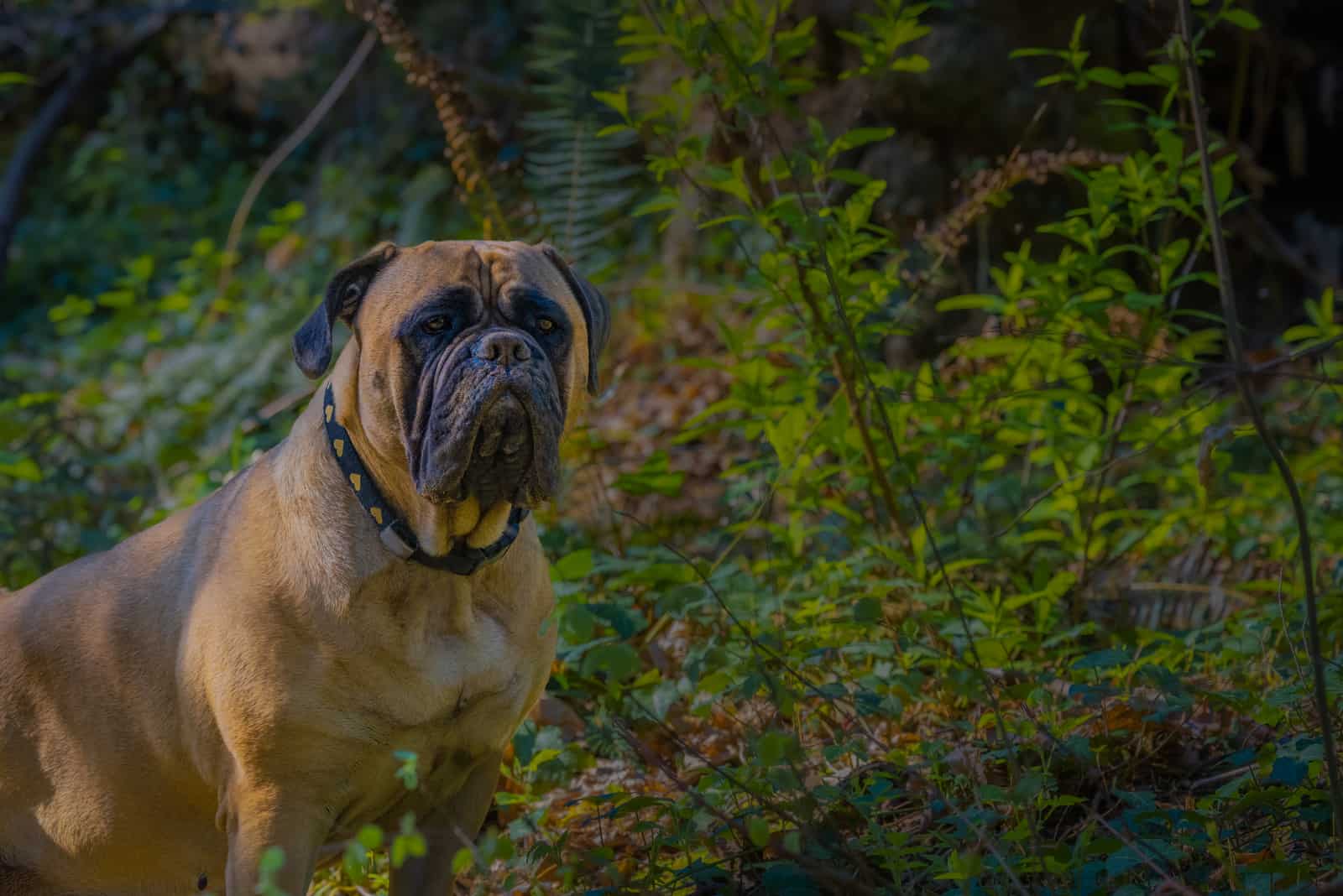
It’s a dense, short coat. It’s what’s known as a single coat, too, meaning that there is only one layer of hair. This makes it pretty easy to maintain, and they won’t shed too much, although it will be fairly consistent all year round. Even so, if you don’t brush them regularly, then those stiff hairs will get everywhere!
Double-coated dogs have a layer of thick fur beneath their topcoat. Bullmastiffs lack this, so you won’t have masses of fur everywhere. Even so, those stiff hairs tend to stick into fabric rather than onto it, making it more difficult to get rid of.
Grooming is the best way to stop this from happening, so invest in a good brush or grooming mitt. Brush them twice weekly and bathe them every five to seven weeks, and you’ll find that their coat will stay in good condition, and you’ll reduce the amount of hair in your home.
These are not classed as hypoallergenic dogs. Does this mean that they’ll be bad for allergy sufferers? Not necessarily! There’s a great deal of confusion and misinformation surrounding the term as it’s often used to describe dogs as being allergen-free.
In truth, there is no such thing. The Poodle is frequently touted as the best dog for allergy sufferers, but you can still have an allergic reaction to them.
Dog allergens are found in proteins in the dog’s saliva, dander, and urine. Dogs lick their fur, which can then fall out around your home with dried saliva attached. Dry skin falls from the dog and is deposited on your furniture, or else it floats in the air. Either way, when you come into contact with the dander and hair, it’s possible that you’ll react to the allergens.
All hypoallergenic means is that you are less likely to have a reaction! A dog can be classed as hypoallergenic if they don’t produce much dander, they don’t shed too much, and they don’t have many allergies themselves.
If you or someone in your family suffers from allergies, it’s a good idea to be tested in order to find out exactly what triggers it, if possible. If the allergy is severe and is proved to be related to dog allergens, then it isn’t a good idea to have any breed of dog in the home. However, if it’s a mild allergy, then it’s advisable to do a little experimentation by making contact with the dog before inviting it into your home.
Perhaps you could visit a Bullmastiff breeder or a friend who owns one? It’s not very scientific, but it could let you know whether this particular breed will trigger your allergy!
Are Bullmastiffs Good Family Dogs?
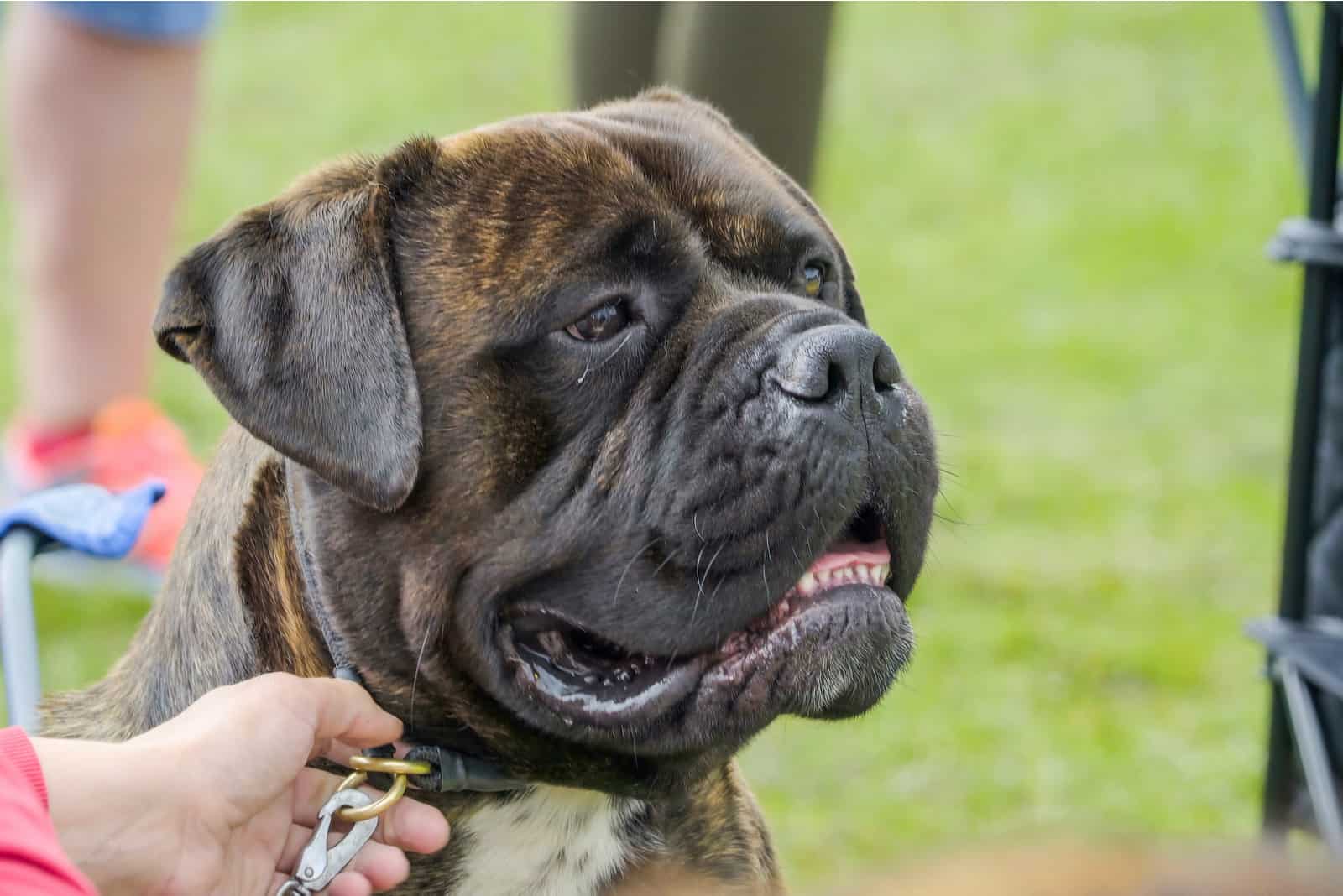
We’re deviating from the subject of Bullmastiff colors to answer this question as it’s a very important one! And, the answer is yes… the Bullmastiff is a good family dog.
You’re not convinced? Then, we’ll look at the facts.
The Bullmastiff dog is quite clearly a large breed. A male Bullmastiff can grow to as much as 27 inches at the shoulder, and weigh up to 130 pounds. That’s an awful lot of dog to have around the home!
Does that mean you need a lot of space? Not necessarily. These massive pooches settle into most places, and are generally placid and docile once they reach adulthood. They’ll settle happily into an apartment as long as you have a park nearby for them to have a run.
You’ll need to set aside at least 30 minutes each day (double this while they are pups) to ensure that your dog gets the right amount of exercise. This should be divided into a couple of moderate walks and some time to run around off-leash, preferably in a fenced area. This is not the sort of dog that makes a good running partner – they aren’t built for long-distance running.
Mature adult Bullmastiffs are considered to be low-energy dogs, and they will be happy with a couple of short walks and playtime, after which, they’ll settle down for a snooze.
When people ask whether a dog will make a good family pet, what they’re really asking about is whether the dog is dangerous or aggressive.
The main problem with the Bullmastiff is its size as this powerful, muscular dog can easily knock people down. Small kids are particularly at risk. Young Bullmastiffs are exuberant and excitable, and they spend a lot of their time bouncing around, which can be a problem. However, they will usually calm down once they reach two years of age.
This is where training is helpful as it teaches the dog how to behave. Training is essential to this breed’s success as a family pet. Just imagine all that power and muscle deciding to do its own thing! You need to have full control over this dog at all times.
One thing in your favor is that these dogs are good in terms of trainability. Most of them love it!
The Bullmastiff dog is not aggressive as such, but they can be protective over family members as well as territorial. They should be okay with the family cat, but they might be wary of strangers or animals crossing the yard. They can also show aggression to other dogs of the same sex. It’s important to teach them how to distinguish between friend and foe, which is why socialization at an early age is a must.
In the end, the Bullmastiff makes a loyal companion. These dogs are intelligent and people-oriented, and they hate being left outside or tied up in the yard. They are affectionate and pretty good with kids, but it’s always best to supervise them just in case.
This big dog wants to please you, to look after you, and to be your watchdog.
Bullmastiff Health Issues
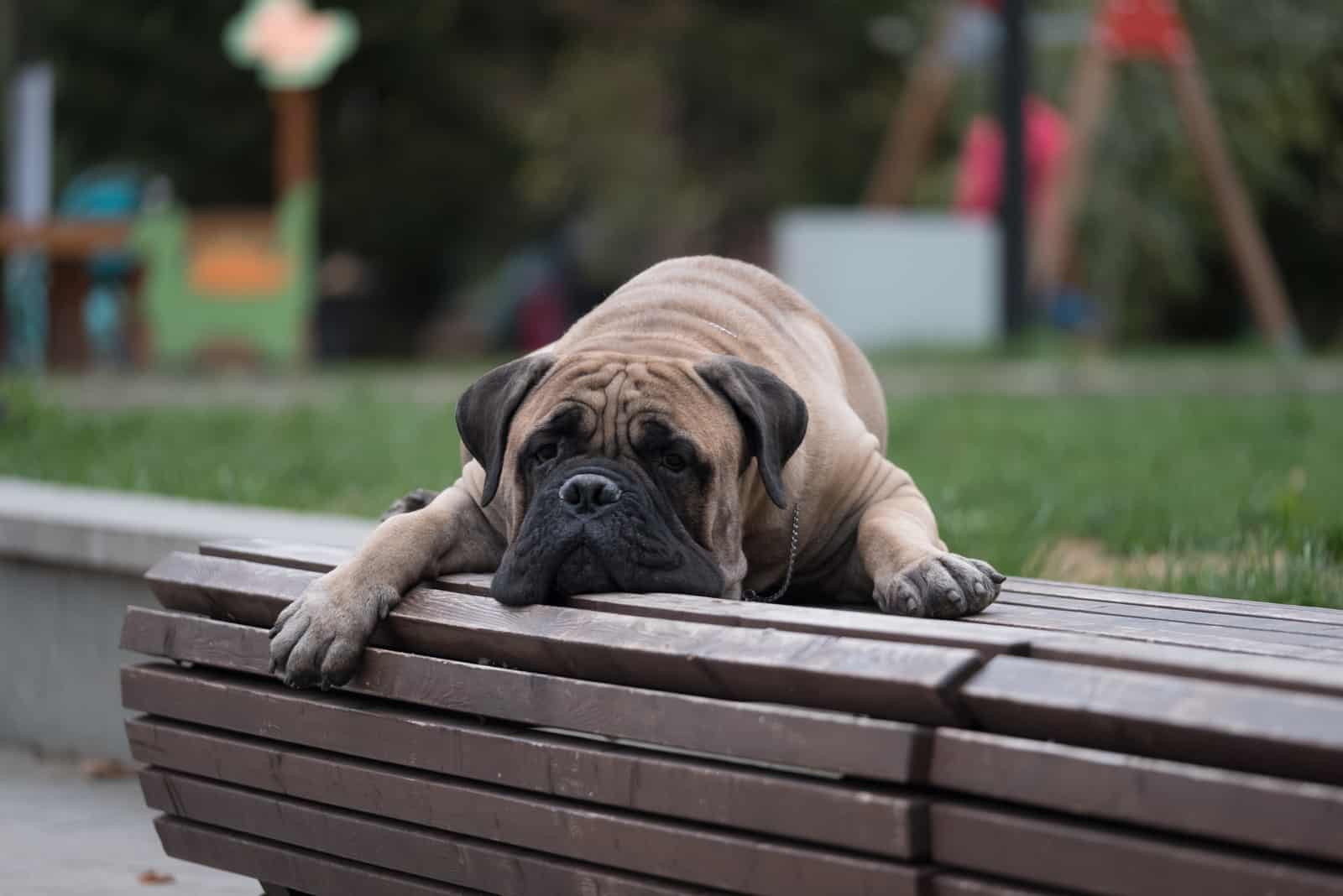
As with any dog breed, the Bullmastiff has its share of health problems. We’ve listed a few here as an example of what to expect:
• Hip dysplasia – a poorly-formed hip joint that causes the bones to grind together painfully. This condition is prevalent in many breeds, and breeders are encouraged to X-ray the parent dogs prior to mating to see if they are potentially carrying the gene that causes it.
• Elbow dysplasia – this is like the hip problem, but trickier because the joint is more complex. Both conditions will lead to arthritis if not treated.
• Entropion/Ectropion – the eyelid folds inward/outward, making the hairs scrape on the cornea. Aside from causing irritation, this can lead to ulcers on the eyeball.
• Hypothyroidism – an underactive thyroid gland that doesn’t produce enough hormones to keep the metabolism running properly. Dogs with this condition will gain weight, even though they lose their appetite. They’ll become lethargic and may experience hair loss.
• Bloat (GDV) – Gastric Dilatation-Volvulus is a potentially fatal condition where the stomach inflates with gas (or liquid) and twists around on itself. Aside from being extremely painful, it cuts off the blood supply to vital organs, and it will kill a dog in a few hours if not treated. Surgery is usually required to fix the problem.
• Cancer – mast cell tumors and lymphoma (cancer of the lymphatic system) are the main culprits in most dogs. Cancer usually affects older dogs, but as the Bullmastiff has a shorter lifespan than many other breeds, it can strike them surprisingly early. Without a diagnosis, a dog can survive for a couple of months on average. After successful treatment, the average survival time is between 12 and 14 months.
• BOAS – Brachycephalic Obstructive Airway Syndrome (it’s easier to say BOAS!) is caused by the dog having a short muzzle. This isn’t usually as severe as when it is seen in Pugs or Bulldogs as they have much shorter muzzles. Brachycephalic breeds have flat faces and short snouts, which causes breathing difficulties. Dogs naturally have long snouts, like the wolf, and this is part of their cooling system. Without this, they can easily overheat or hyperventilate. Many owners of brachycephalic dogs mistake the choking noises for sneezing, coughing, or even snoring, when, in fact, the dog is struggling to breathe. In multiple cases, this results in death.
One of the best ways to avoid these health conditions is to find a reputable, ethical, and responsible breeder. They will usually have health screening measures in place to significantly reduce the chances of your pup inheriting any of these horrible health problems.
With your help, you can extend your dog’s lifespan beyond the average!
How Much Do Bullmastiffs Cost?
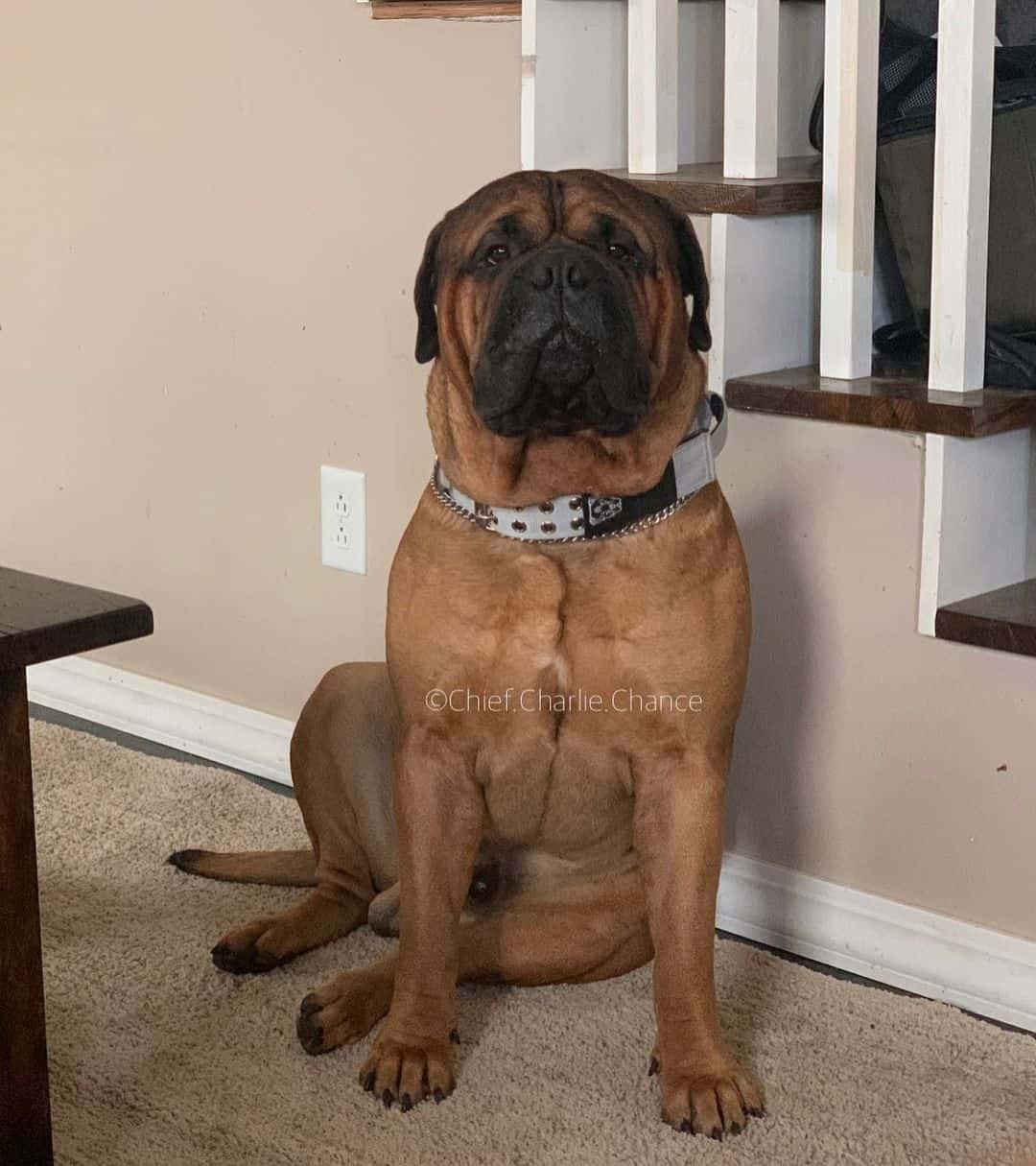
Photo from: @chief.charlie.chance
A healthy Bullmastiff puppy from a good, reputable breeder will cost you between $1,200 and $2,500. If it’s a particularly good breeding line, it could cost $3,500 or more.
The actual price will depend on the age and sex of the dog (females are generally more because of breeding potential) as well as the location of the breeder.
In the USA, dog prices are higher in the north than in the south as there is a greater concentration of breeders in the south, meaning that there are more choices. Breeders need to keep their prices low in order to attract buyers.
Shelters and rescue centers offer a more affordable option as you can pick up your dog for a donation of between $100 and $500. This fee is used to cover the cost of feeding, housing, vaccination, and sometimes it even includes spaying/neutering.
Ever wonder why breeders charge so much? This is because breeding is an expensive business! Puppy mills and backyard breeders will often sell pups cheaply because they don’t have the same overhead. To them, it’s all about the profit.
Ethical breeders are focused on producing healthy pups and preserving the breed in its purest form. They spend most of their profits (if they make any!) on improving the quality of health screening and care for their beloved dogs. They’ll show interest in where their pups are going, and they will be happy to keep in touch to offer advice as your pup grows.
It’s essential to choose your breeder wisely.
Don’t forget, the cost of a Bullmastiff doesn’t end when you hand over the cash and take your pup home. In some ways, the true cost is just beginning.
You’ll need a bed and/or a crate for your new arrival. You’ll need to buy chew toys, blankets, a leash and collar, food and water bowls, and good-quality puppy food. And, that’s just the start!
Dog training and obedience classes, dog-sitting, professional groomers, dog-walkers, vet bills, kennels (if you have to go away and can’t take your furry friend) – all of these possibilities have to be taken into consideration.
Pet insurance is a great idea as it can help with any sudden unexpected costs relating to injury or sickness. Being financially prepared for owning a dog is just as important as getting your home ready. It’s a big responsibility, and you must be certain that you can look after your dog before taking it on.
Also, be prepared for a big food bill! Depending on your dog’s size and age, the cost of food and treats for a single year could be as high as $1,400.
On that note, it might come as a shock to discover that a Bullmastiff could cost you around $19,000 over its lifetime.
In Summary
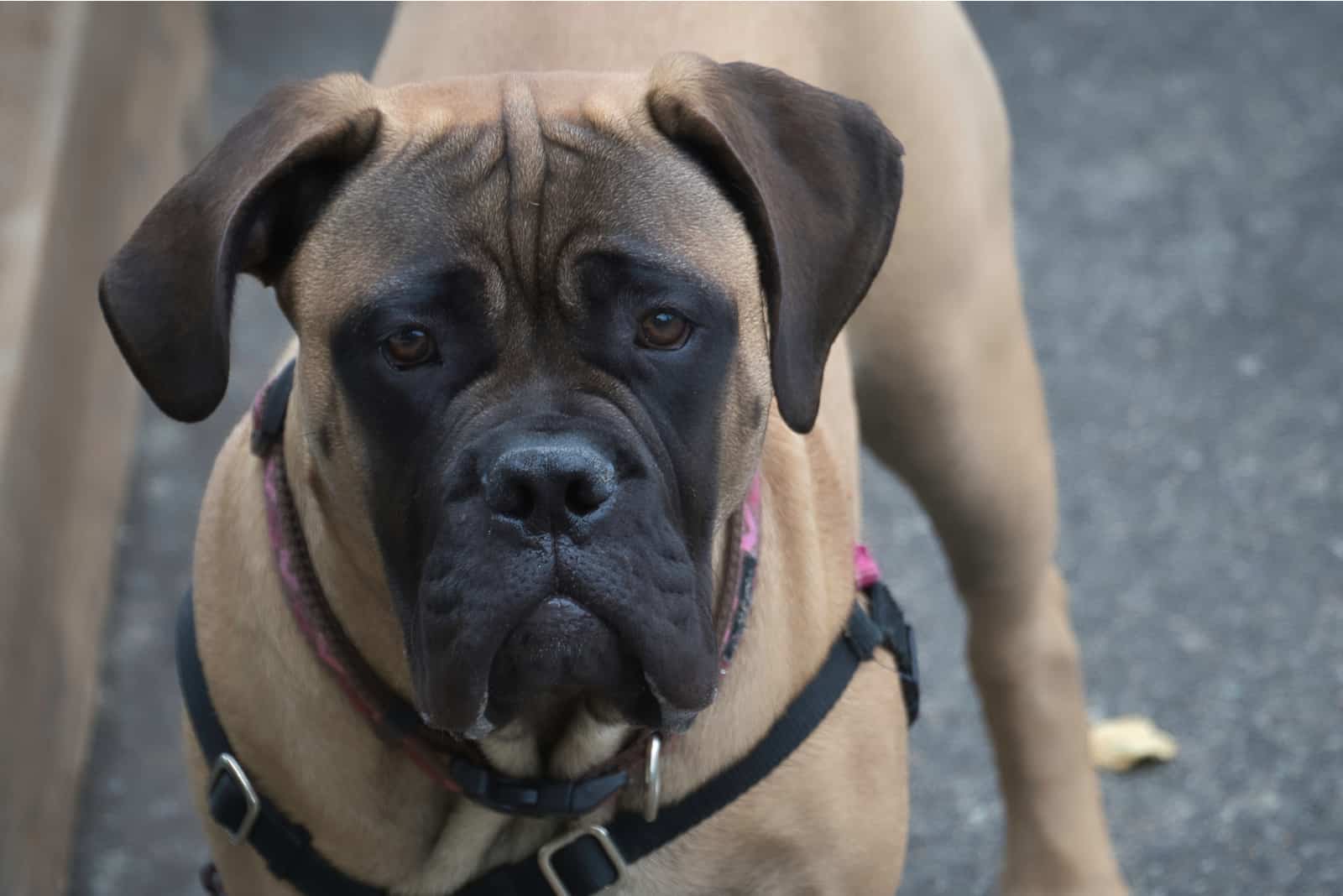
We’ve talked about a lot more than Bullmastiff colors, but it’s important to understand a breed as a whole, and not only concentrate on one aspect.
If you choose to welcome a Bullmastiff into your home, you need to be prepared. He is going to snore and drool and eat a lot of dog food! He’ll need training and socializing, and a fair amount of exercise, especially in his first two years. If he’s bored, he’ll chew stuff or dig.
But, if you put in the effort, you’ll have a friend for life.
And, that’s another thing to prepare yourself for: this is a big dog, so it has a relatively short lifespan. You can play your part by caring for him, but he may only be around for seven years, and not much longer than nine or ten years.
There aren’t many Bullmastiff colors to choose from, and all of them are beautiful, whether red, fawn, or brindle. The fact that there are only three main colors makes your decision easier!
However, the important thing is to decide whether this is the dog for you, or whether you should go for another breed.
If his immense size doesn’t put you off, or the pools of drool don’t gross you out, or the snoring like a giant buzzsaw doesn’t drive you insane, then there’s a glimmer of hope. If you can commit to looking after him, devoting yourself to training and exercise, keeping him well-groomed, and providing a healthy, balanced diet, then it’s looking even better.
He’ll reward you for this with absolute devotion. He may be too big to curl up on the sofa for a cuddle, so he’ll make do with leaning against your legs, possibly with his massive head on your knee.
So, whether fawn, brindle, or red, the Bullmastiff might just be the right match for you!
